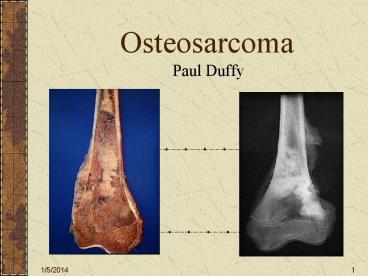Osteosarcoma - PowerPoint PPT Presentation
1 / 36
Title: Osteosarcoma
1
Osteosarcoma
- Paul Duffy
2
Overview
- Definition
- Epidemiology
- Pathogenesis
- Skeletal distribution
- Clinical presentation
- Evaluation
- High grade osteosarcoma
- Parosteal osteosarcoma
- Periosteal osteosarcoma
- High grade surface osteosarcoma
3
Definition
- 2nd most common primary bone tumor
- Malignant tumor of mesenchymal origin
- Spindle shaped cells that produce osteoid
4
Epidemiology
- Any age
- 75 12-25yrs
- Modal incidence
5
Epidemiology
- Primary vs secondary
- Male female
- Li Fraunie syndrome
6
Pathogenesis
- Unknown
- Modal incidence correlates with rapid bone growth
- Radiation exposure
- Cancer survivors
- Retinoblastoma
7
Skeletal distribution
8
Classification
9
Clinical Presentation
- Painful mass arising from bone
- Trauma
- Metastisize early in evolution
- 20 clinically detectable mets at dx
10
Evaluation
- Suspected diagnosis by hx and physical
- Supported by xray
11
Plain Xray
- Lytic, sclerotic or mixed
- Typical characteristics of malignant tumor
- Ennekings 4 questions
12
Initial Evaluation
- Define the extent of the disease
- Locally
- Systemically
13
Local
- CT
- MRI
- /- Angiogram
14
CT
15
MRI
16
Angio
17
Systemic
- Bone scan
- CT Chest
- lab
18
Classic High Grade Osteosarc
- Age, sex
- Presentation
- Physical exam
- Blood work
- Plain films
- Site
- size
19
Differential Dx
- Giant Cell Tumor
- Aneursymal Bone Cyst
- Ewings
- Osteoblastoma
- Metastasis
- Lymphoma
20
Biopsy
- Principles
- Dx high grade osteosarcoma
- Now What??
21
Chemotherapy
- Micro metastasis
- What we have learned pre chemo (1970s)
- Multi Institutional Osteosarcoma Study
22
Chemotherapy
- Chemo cannot control clinically detectable
disease - Radiation is ineffective
- Local control is surgical
23
Chemotherapy
- Best protocol is subject of ongoing trials
- Drugs
- Doxorubicin
- Cisplatin
- Ifosfamide
- Methotrexate
- Cyclophosphamide
- Side effects
24
Induction Chemotherapy
- Arose in conjunction with development of limb
sparing surgery - Increase survival
- prognostic
25
Surgery
- Limb salvage the norm
- Now safer procedure
- Wide surgical margin
26
Surgical options
- Articular surface removed
- Osteoarticular allograft replacement
- Custom modular prosthesis
- Allograft prosthesis composite
- Allograft arthodesis
- Segment of diaphysis missing
- Intercalary allograft
27
Surgery
- Young patient with open growth plate
- Rotatioplasty
- Conventional amputation
28
(No Transcript)
29
Surgery
- Indication for amputation
- Grossly displaced pathologic fracture
- Encasement of neurovascular bundle
- Tumor that enlarges during preop chemo and is
adjacent to neurovascular bundle
30
Current Standard of Care
- Pretreatment radiologic staging
- Bx to confirm diagnosis
- Preoperative chemotherapy
- Repeat radiologic staging
- (access chemo response, finalize surgical tx
plan) - Surgical resection with wide margin
- Reconstruction using one of many technoques
- Post op chemo based on preop response
31
Surface osteosarcoma
- Parosteal
- Periosteal
- High grade surface osteosarcoma
32
Parosteal
- 5 of osteosarcomas
- Posterior metaphysis of distal femur
- Slow growing large ossified mass
- Confused with osteochondroma
- String sign
- Low grade
- treatment
33
Parosteal Osteosarcoma
34
Parosteal Osteosarcoma
35
Periosteal Osteosarcoma
- Arises from surface of diaphysis
- Characterized by bony spicule formation
perpendicular to shaft - Sunburst
- Low grade
- Wide excision
36
High grade surface
- Very rare
- 20-30s
- Appearance as parosteal but histology high grade
- Tx as classic intermedullary

